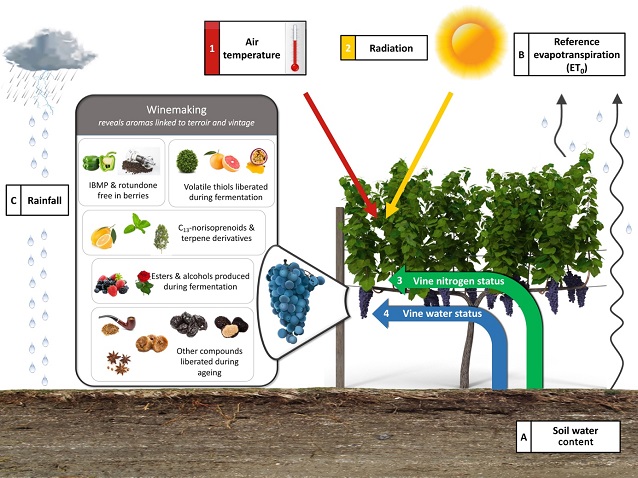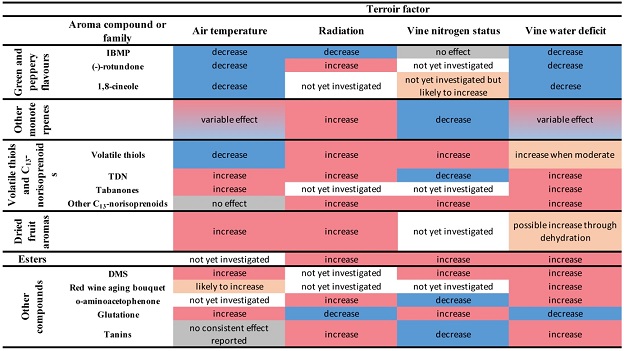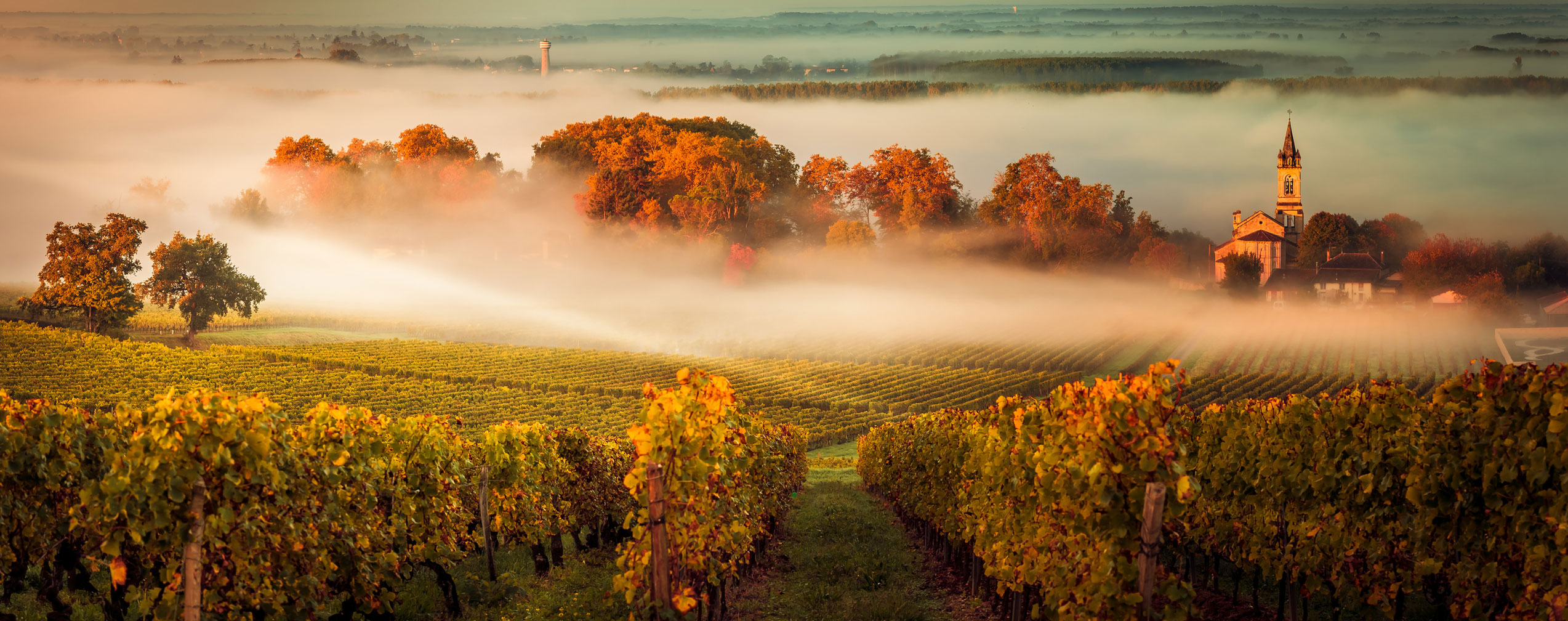That’s the thinking behind a study in Bordeaux, France, which looked at the connection between aromas and terroir in general and then for three major red grape varieties (Merlot, Cabernet Sauvignon and Syrah) and two white varieties (Sauvignon Blanc and Riesling). The study, published in two parts in IVES Technical Reviews, also examined how wine aromas can be optimised through vineyard management practices.
Decomposing terroir into quantifiable parameters
In addition to winemaking techniques, wine quality and typicity is linked to the place where the grapes are grown. This relationship between the wine’s sensory attributes and its origin is referred to as “terroir expression”. Climate, soil and the cultivar are major drivers of this terroir expression. It can be assumed that the influence of climate and soil is expressed through the grapevine variety, which is mediated by the rootstock. To understand the role of climate and soil in grape and wine composition, it needs to be decomposed into measurable parameters.Climate influences on vine development and grape ripening are mainly associated with temperature, radiation and rainfall. Temperature drives phenology (the timing of developmental stages like budbreak, flowering and veraison) and grape ripening. Grape composition at ripeness is also temperature dependent. Radiation (associated with sunlight) provides the energy for the process of photosynthesis and has a major impact on the accumulation of secondary metabolites (tannins which mainly accumulate prior to veraison; anthocyanins and aroma compounds which accumulate during grape ripening) in grapes. Soil influences are primarily associated with nitrogen supply and water availability. Vine nitrogen status acts on vigour, vegetative expression, yield and grape composition at ripeness. Vine water status – which is the result of the combined effect of rainfall, irrigation, reference evapotranspiration, soil water content and canopy architecture – drives shoot growth, yield and grape ripening, and has a major impact on grape composition at ripeness. Temperature, rainfall and radiation data can easily be acquired by the measurement devices of a weather station. Several techniques are available for assessing vine water and nitrogen status. The quantification of these major terroir factors opens the door to a better understanding of their impact on aromatic composition of wines (Figure 1, below).

Figure 1. Overview of the terroir effect on aromas in grapes and wines.
Terroir expression is mainly mediated through (1) air temperature (climate), (2) radiation (climate), (3) vine nitrogen status (soil), and (4) vine water status, which results from (A) soil water content (soil), (B) reference evapotranspiration (climate), and (C) rainfall (climate). These four components related to soil and climate impact aroma composition and expression in grapes and wines.
The importance of aromas
The aromatic profile of wine (linked to typicity expression) is highly influenced by secondary metabolites, in particular aroma compounds. Hundreds of aroma compounds have been identified in grapes and wines and they can be classified according to the aromatic nuances they induce and the chemical family they belong to (Figure 1, above, and Table 1, below). Volatile compounds are rarely variety specific. Although their concentration varies with the variety (eg. Cabernet Sauvignon produces more IBMP than Merlot), they are also impacted by the environmental conditions of the vineyard (ie. the terroir). It should be noted that wine typicity – especially its aroma profile – is also influenced by grape harvest dates.Impact of specific terroir parameters on aromas in grapes and wines
Air temperatureCool growing conditions favour green aromas in grapes and wines, which can be induced by IBMP (bell pepper nuances) or 1,8-cineole (Table 1, below). High concentrations of IBMP are not desirable in red wine, but moderate levels of IBMP in Sauvignon Blanc are appreciated, because they bring freshness to the wine. Syrah grown in cool climates has higher levels of (-)-rotundone (pepper nuances), which is considered, to a certain extent, as a quality factor. Volatile thiols (in particular 3-SH, grapefruit nuances) are negatively influenced by high temperatures, while Riesling grown in warm conditions contains more TDN (kerosene nuances). Moderately warm conditions favour DMS levels, which are implicated in the complexity of aged wines, while hot conditions trigger cooked fruit aromas, reducing the complexity and ageing potential of red wines.
Radiation (sunlight)
High levels of radiation decrease the concentration of IBMP in grapes and wines, while (-)-rotundone can be enhanced by exposure of the grapes to sun. High radiation has globally a positive effect on wine aromas, in particular on monoterpenes, volatile thiols (3-SH) and TDN. However, excessively high radiation may trigger the presence of ortho aminoacetophenone (AAP, nuances of atypical ageing) in white wine and cooked fruit aromas in red wine, which are putative factors driving premature ageing. In white grapes relying on volatile thiols for their aroma expression (in particular Sauvignon Blanc) a side effect of high radiation is an increase in skin phenolics. These may be transformed into quinones during prefermentation operations, which can destroy a part of the precursors of volatile thiols or react with glutathione, a powerful antioxidant compound which has a preserving effect on these aromas.
Nitrogen
Although vine nitrogen status does not have a direct impact on the synthesis of IBMP, unlimited nitrogen uptake may increase vigour and create a cool and shaded microclimate in the bunch zone, indirectly reducing the degradation of green aromas. The synthesis of precursors of volatile thiols is enhanced by nitrogen, as is the production of esters during fermentation, leading to more fruity wines. The production of DMS is triggered by nitrogen, favouring the development of an attractive ageing bouquet. In Riesling, the concentration of TDN and AAP is reduced under increased nitrogen status. A side effect of nitrogen is that it reduces skin phenolics and increases must glutathione, limiting the risk of volatile thiol degradation through quinones. The absence of a limitation in nitrogen supply is globally favourable for aroma expression in wines, but excessive nitrogen should be avoided, because it promotes vigour and may induce Botrytis cinerea infection.
Water
Vine water status is the result of the combined effect of climate (rainfall and reference evapotranspiration), irrigation (if applied) and soil (soil water content). Water deficit is generally favourable for aroma expression in wines, because it reduces green aromas (in particular IBMP) and increases monoterpenes, C13-norisoprenoids and volatile thiols (on the condition that the deficit is moderate). However, it is also known to decrease (-)-rotundone and therefore to affect the peppery typicity. When vines meet water deficit during the berry ripening period, the produced wines develop a more attractive ageing bouquet. Severe water stress, however, promotes atypical ageing related to the development of AAP in Riesling, and may trigger cooked fruit aromas in red wines, probably as an indirect effect of berry shrivel.

Table 1. Effect of four terroir factors (air temperature, radiation, vine nitrogen status, and vine water deficit) on aroma compounds in grapes and wines.
Examples of aroma profiles related to specific terroirs
Sauvignon Blanc is grown under a wide range of climatic conditions and soil types. Typical cool-climate Sauvignon Blanc is produced in Marlborough (New Zealand), the Elgin region (South Africa) and Sancerre (France). Its aroma nuances are shaped by a delicate balance between green aromas (bell pepper induced by IBMP and boxwood by 4-MSP) and fruity aromas (grapefruit induced by 3-SH and passion fruit by 3-SHA). Examples of warm-climate Sauvignon Blanc can be found in California and Australia. The aroma profile of these is dominated by passion fruit or, if the region is really hot, by a lack of aromatic expression. The archetype of cool-climate Sauvignon Blanc is produced in the Awatere Valley (a subregion of Marlborough). The aroma profile here is dominated by green aromas (asparagus, boxtree), and grapefruit. Bordeaux is a major winegrowing area for Sauvignon Blanc where the climate is temperate. The most expressive Sauvignon Blanc is produced in the cooler parts of the Bordeaux area, on soils with medium to high water-holding capacity and medium to high in nitrogen supply.Merlot and Cabernet Sauvignon grown in cool climates, or with low radiation, can be green, because of the presence of IBMP. An excess of IBMP is generally not appreciated, although some green aromas, like 1,8-cineole, can provide minty freshness in the aroma expression. Merlot and Cabernet Sauvignon grown in temperate climates express fruity flavours and develop a complex ageing bouquet after a few years of bottle storage. These positive characters are induced by a wide range of compounds, including substituted esters, volatile thiols (in particular 3-SH) and DMS. Aroma expression after bottle ageing is enhanced when wines are produced by vines facing water deficits. It has been shown that these wines contain more DMS and tabanones. Under warm climates, wines from these two popular red varieties can express dried fruit aromas, in particular when produced from Merlot. Some of the finest wines from Cabernet Sauvignon are produced in Margaux, Saint-Julien, Pauillac and Saint-Estèphe (in Bordeaux, France). In the Bordeaux area, Cabernet Sauvignon ripens late in the season, when temperatures are decreasing, eliminating any possible risk of dried fruit aromas. The gravel soils of these appellations induce an interesting combination of moderate to severe water deficit and unlimited nitrogen supply to the vines. This combination of cool climate, water deficit, and unlimited nitrogen can shape beautiful ageing bouquets.
Syrah can express different aromatic identities depending on the climate. In cool-climate vineyards, such as those from the northern Rhone Valley in France, Victoria’s Grampians region in Australia, or the Hawke's Bay area in New Zealand, Syrah expresses very intense peppery aromas, induced by the presence of (-)-rotundone. In warmer climates (ie. unirrigated vineyards in the coastal parts of the Languedoc area or southern Rhone Valley in France, Barossa Valley in Australia), Syrah is rather marked by the expression of ripe and dried fruit, and black olive aromas. DMS has been identified as a major contributor to these notes.
The typicity of Riesling wines is shaped by various aromatic nuances, which reflect growing conditions, in particular temperature and vine water status. Typical cool-climate Riesling wines, as grown in Europe (eg. Germany, Alsace, Austria), are marked by the fruity aromas induced by volatile thiols, among other compounds, although this expression may change with increasing temperatures. Bottle aged bouquet, especially in Riesling wines from warmer climates, like Australia or South Africa, but also from United States or Canada, contains more kerosene-like aromas as a result of the presence of TDN. When Riesling is grown under high radiation and water deficits, the presence of ortho aminoacetophenone (AAP) can lead to atypical ageing, in particular when vine nitrogen status is low.
Managing terroir-induced aroma expression in the vineyard
Terroir factors (temperature, radiation, water, nitrogen) induce specific aromatic typicities. The choice of plant material and vineyard operations can, however, modulate this expression. The excessive presence of green aromas is generally not appreciated in red wines. They are often the result of low temperatures during grape ripening, low light intensity, unlimited water supply and/or unlimited nitrogen supply. The presence of green flavours can be reduced by planting early ripening varieties (Merlot instead of Cabernet Sauvignon).Another option is reducing nitrogen availability by planting cover crop or increasing exposure to light by leaf removal (which will also increase the temperature in the bunch zone). Under warm climates there is a risk of producing red wines that are excessively marked by overriding and “trivial” dried fruit aromas, which reduces freshness and aromatic complexity. These can be limited by planting later ripening varieties (Cabernet Sauvignon instead of Merlot). Other options are earlier harvest dates or increased vegetative expression and vigour to expose bunches to less direct sunlight.
In Sauvignon Blanc, grapefruit expression can easily be enhanced by nitrogen fertilisation (when soil N supply is limited), either through foliar application or additions on the soil. In warm climates, or on soils inducing moderate to severe water deficits, red varieties should be preferred over Sauvignon Blanc or other early ripening white varieties for the production of high-quality wines. Berry temperature and light can be manipulated through canopy management and leaf removal. The effects of varietal choices and management practices to modulate aroma expression linked to terroir are summarised in Table 2 (below). Harvest date also has an important impact on wine typicity.

Original article and research by Cornelis van Leeuwen, Jean-Christophe Barbe, Olivier Geffroy, Mark Gowdy, Georgia Lytra, Alexandre Pons, Cécile Thibon, Stéphanie Marchand.
This article was published in two parts in IVES Technical Reviews. Part one looked at how terroir shapes aromatic typicity in grapes and wines. Part two looked at examples of the terroir effect on major grape varieties and how wine aromas can be optimised through vineyard management practices.













.png)






